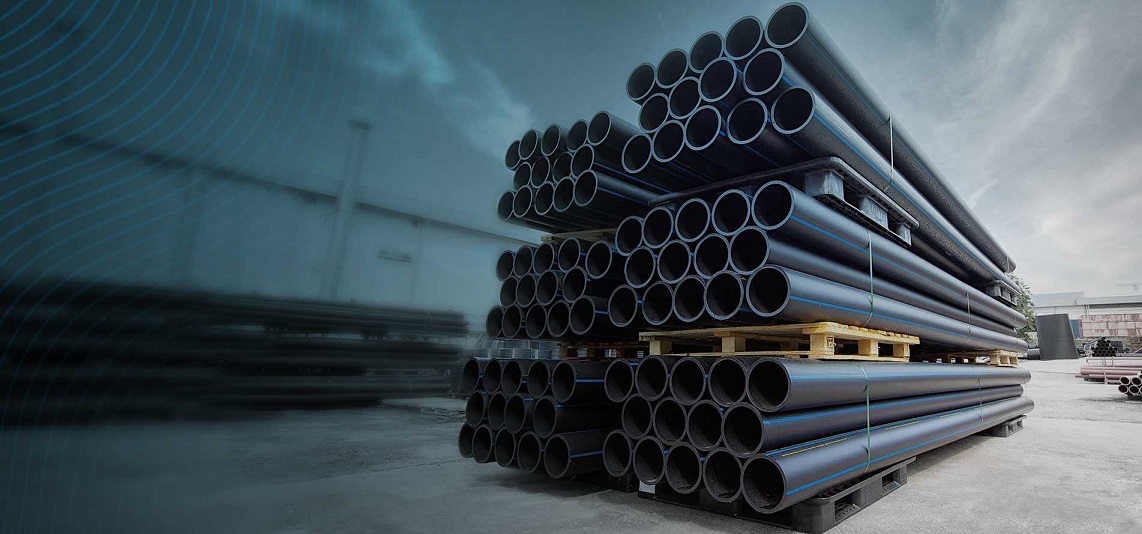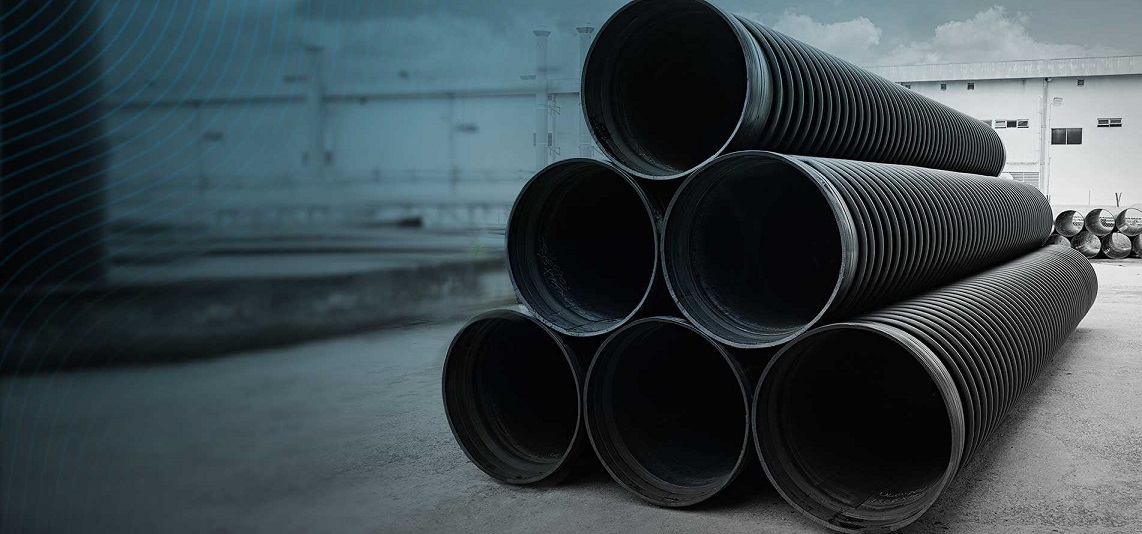polyethylene pipes export
The polyethylene pipes export and their production industry have undergone many advances in the last fifty years. And these pipes have also established themselves as a suitable alternative to metal, GRP, PVC and cast iron pipes. In most cases, it can be used as an alternative to such pipes.
Today, polyethylene piping systems are used in a wide range of urban, industrial, marine, drilling, landfill and agricultural pipelines. Due to the smoothness and flatness inside the polyethylene pipes, it does not become clogged in any way. And over time, these pipes will not rot or corrode. Therefore, it is suitable and hygienic for transferring drinking water.
Polyethylene pipes are made of HDPE, which is abbreviated as pe. These pipes have good flexibility and are very suitable against bending. Which has a much longer useful life than other pipes. For nominal pressure from 3.2 to 20 bar and nominal external diameter from 16 to 1600 mm and temperature range between zero to 70 degrees Celsius.
The term PN is used after the size of the polyethylene pipe. Indicates the maximum pressure that the pipe can withstand. For example, pipe DN63, PE100, PN16 means a pipe made of PE100 material and has a diameter of 63 mm and must withstand 16 times the pressure.
Types of polyethylene pipes in terms of working grade
These pipes are widely used in water supply and irrigation. These pipes are divided into three grades PE63, PE80 and PE100 based on the thickness and the amount of tolerable pressure. PE63 grade is rarely used today.
* PE63 grade
PE63 grade is used only for the production of polyethylene sewer pipes up to 5 inches in size. The safety factor in this grade is 1.6. PE63 grade is not economical due to its thickness and high weight, so at present, this category is less used.
* PE80 grade
PE80 grade is lower than PE63 grade in terms of weight, thickness and price. The higher the density of raw materials. The thickness of the pipe is reduced and the weight of the polyethylene is reduced. The safety factor in this model is 1.25. Also, in this grade, with increasing density, the amount of pressure tolerated has increased.
* PE100 grade
PE100 grade is made using the best raw materials, the newest and lightest type of raw materials. It has less weight and thickness than the previous two grades. And the most important advantage is excellent quality, high flexibility. These features make it easier to maintain and install polyethylene pipe.
Export of polyethylene pipes
Types of polyethylene materials based on density
One of the most obvious characteristics for buying and the export polyethylene pipes is their molecular mass or density, which is classified according to which they are as follows:
Low density polyethylene
Low density polyethylene or LDPE This type of polyethylene has a large number of branches or side branches and more than usual. The density of materials in this type of polyethylene pipe is less than 0.926 grams per cubic centimeter.
In this type of polyethylene, the distance between molecular chains is large. This large distance causes the density to decrease. Their features include expandability, low heat resistance, low strength and many other advantages. This type of pipe can withstand less than 3 bar pressure. LDPE differs from other types of polyethylene pipes in that it is more suitable for surface installation.
Low density and linear polyethylene
Low Density Polyethylene or LLDPE In the process of producing polyethylene, when a normal butene commonomer is added to ethylene, the product will have more side branches but equal length. Although these branches are long, they are few in number along the polymer chain.
Due to the linearity of the polymer chain, this type of polyethylene is called linear polyethylene. The most common use of this polyethylene pipe is in drip irrigation systems, although it can be used in sewage, sanitation, industrial production lines, agricultural piping and other systems that do not withstand high pressures or temperatures. They also used.
Medium density polyethylene
Medium density polyethylene or MDPE This type of polyethylene has better efficiency in terms of strength as well as high strength and impact resistance. The density of materials in this type of polyethylene pipe is between 0.926 to 0.940 g / cm3 and per Cm of its thickness bears less pressure than HPDE. Due to its stability at room temperature, excellent impact resistance, lower sensitivity to HDPE and many other properties of MDPE, it is used in some parts of gas piping and cold drinking water transmission systems.
High density polyethylene
High density polyethylene or HDPE The density of this type of polyethylene pipe is 0.941 grams per cubic centimeter or more. Compared to other polyethylenes, this type of product has a higher crystallization structure of the polymer chain, therefore it has a more compact structure and a higher density, which is why it is called heavy polyethylene. This type of polyethylene has fewer side branches than other polyethylenes. HPDE polyethylene pipe is the best choice for irrigation systems.
polyethylene pipes export
It should be noted that there are different types of polyethylene pipes, some of the most important of which are the following:
Single wall polyethylene pipe
Single-walled polyethylene pipe is one of the polymer pipes. Single-walled polyethylene pipe can withstand pressure between 20 to 40 bar.
Double-walled polyethylene pipe
Double-walled polyethylene pipes, also known as corrugated pipes. They can withstand different pressures up to 6 times. And can be produced for more loads. Carogit pipes have two walls.
One is inside the tube and facilitates the passage of fluids, the other is outside the wall of these tubes are tubes. Which have a ring-like appearance. And have a smooth surface. This type of pipe is used to move fluids with the nature of acidic and alkaline wastewater as well as industrial effluents.
Spiral polyethylene pipe
These pipes can be considered as different types of polyethylene pipes. Which are like corrugated pipes. But in terms of sizing, they are generally made in the range of 800 to 3000 mm. They are different from them.
These pipes have a high strength. Working pressure or the same as ring pressure in spiral corrugated pipes can. 16 kN, 31.5 kN, 64 kN. This pressure is directly related to the thickness of the congresses and the outer wall of the corrugated spiral pipes. And it can be designed and offered up to 6 meters in length with 3 meters in length and up to 3 meters in diameter.
What are the advantages of polyethylene pipes that have increased the export volume of polyethylene pipes?
With the production and manufacture of polyethylene pipes, as it was said, there was a huge change in the industry and construction, which today we are faced with even cases such as smart homes and similar cases, and this application enjoys the many benefits of these products. Benefits include:
Proper flowability
Since the inner surface of polyethylene pipes and fittings is smooth and very low in roughness, the fluids inside it flow rapidly, and this is due to the roughness coefficient of about 0.007 polyethylene pipes and fittings and have a lower friction drop.
Corrosion resistant
These properties are in fact the most important factor in the use of polyethylene pipes in the sea because the combination of air and water, especially seawater, is very corrosive for other types of pipes and polyethylene pipes are highly resistant to corrosion.
Shelf life of polyethylene pipe
Shelf life of polyethylene pipes provided they are properly designed and installed. It averages between 50 and 100 years. This durability and longevity saves on the cost of replacing these pipes.
Earthquake Resistant
Due to the high coefficient of tensile strength of polyethylene materials and sufficient strength against impact pressure, polyethylene pipes show the best resistance to seismic vibrations and displacement of soil layers.
Flexibility of polyethylene
Due to these characteristics, the installation of polyethylene pipes will be easier and also the need to use a variety of fittings is very low. Usually, the allowable bending radius of polyethylene pipes is on average 20 times their outer diameter.
Chemical resistant
Acidic and alkaline environments, as well as many solutions and chemicals, do not affect polyethylene. This is one of the most important advantages of polyethylene pipes and polyethylene fittings.
Resistant to sunlight
Polyethylene pipe can be considered as one of the few polyethylene products that have been able to make its materials resistant to the sun’s ultraviolet rays through research and development. Today, with the right black raw materials and modern production equipment, do not worry about the resistance of polyethylene pipes to UV rays.
Low weight polyethylene pipes
Due to the lower weight of these pipes than steel pipes, they will be much easier and more convenient to transport and store, and thus reduce the cost of all projects.
Resistant to rot, abrasion and impact
Using standard consumables to resist rot, wear, corrosion and impact will increase the useful life of polyethylene pipe.
Low maintenance costs
Due to the long life of these pipes, less repairs are needed and if necessary, they are repaired at a very low cost, while repairing steel pipes or cast iron pipes and fittings with problems such as the inability to repair the pipe cover. It is accompanied by the seabed.






